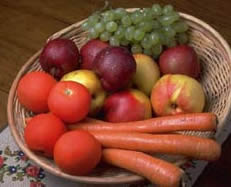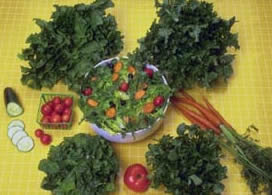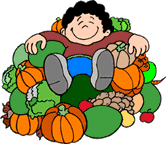|
A recent issue of Consumer Reports pointed out the health benefits of eating a "rainbow of produce." Even on the face of it, this seems more sensible than a monochrome, all-mauve dietary approach, even if it is the latest thing in Hollywood.
Indeed, the body does benefit from eating a variety of hues. In this article, we'll talk about why that is, and we'll tell you about a small but very important detail that the magazine article forgot to mention.
We all know about protein, fat, and carbohydrates—they're the most rudimentary classifications of food. Beyond that, we know about important vitamins like A, C, E, D, and B complex, as well as essential minerals like zinc, chromium, calcium, and magnesium. But there are also hundreds of "micronutrients"—nutrients
 that are required in lower quantities but are nonetheless essential to keeping your body's intricate systems functioning properly.
that are required in lower quantities but are nonetheless essential to keeping your body's intricate systems functioning properly.
Eating the full rainbow assortment of fresh raw fruits and vegetables on a regular basis—in addition to eating whole grains, nuts, seeds, and legumes while moderating intake of animal fat, refined flour, sugar, and stimulants—is the key to giving your body the nutrients it needs to build cells right and strengthening your immune and detoxification systems so they can do a better job of fighting off disease and aging.
Many nutrients are associated with various colors. Take the carotenes, for instance, which are important antioxidants that range in color from deep yellow to deep red. (Note: There are many carotenes other than top-dog "beta carotene.") Anthocyanins are another class of essential "phytochemicals" and can be found in foods colored anywhere from black, blue and purple to reddish. Flavinoids come in a similarly varied assortment of colored foods. Even white vegetables can be helpful; for instance, those from the onion family supply allicin, which is thought to boost the immune system, fight heart disease, and reduce the risk of cancer.
 Perhaps the most important color in the "rainbow diet" is green. Dark-green leafy vegetables—such as kale, collars,
chard, spinach, tat soy, and bok choy—are packed with important nutrients. These include omega 3 essential fatty acids, which are critical for building good quality cells in the body and may be important in regulating inflammation. Most people eating a Western diet are deficient in omega 3's. Other great green veggies include broccoli, cabbage, and the green portions of scallions, chives and leeks.
Perhaps the most important color in the "rainbow diet" is green. Dark-green leafy vegetables—such as kale, collars,
chard, spinach, tat soy, and bok choy—are packed with important nutrients. These include omega 3 essential fatty acids, which are critical for building good quality cells in the body and may be important in regulating inflammation. Most people eating a Western diet are deficient in omega 3's. Other great green veggies include broccoli, cabbage, and the green portions of scallions, chives and leeks.
In the farm field, all foods are not created equal. The nutrient quality of the food you eat will largely depend on the nutrient quality of the soil the food was grown in. In industrial agriculture—the type of farming that supplies the vast majority of fruits and vegetables in the supermarket—farmers usually apply a only a nitrogen-potassium-phosphorus (NPK) fertilizer to the farm fields. While the NPK fertilizer does supply the primary ingredients needed to make plants grow fast and tall, it does little to supply the nutrients needed to allow plants to grow RICH—that is, rich in macro- and micronutrients alike.
On an organic farm, soil quality is maintained through the use of organic matter like manure and field waste, which is digested and turned into useable nutrients by worms, nematodes, bacteria, mycorhizal fungi, and other organisms found in healthy soil. Additionally, cover crops are often grown to improve soil quality and prevent loss of precious top soil.
All this care and nurturing of the "dirt" ends up creating soil that is richer in nutrients than soil found on industrial farms. When the plants suck up sustenance from the organic soil, the nutrient mix results in a fruit or vegetable that is more densely packed with a wider variety of nutrients. Not only do soils on conventional farms not get the broad-spectrum replenishment they need, the toxicity of the chemical pesticides and fertilizers used kill a large percentage of the beneficial organisms that are essential for good soil health.
There's one other reason why the rainbow diet will benefit you more if it comes from organic or "sustainably grown" food. Many of the beneficial micronutrients in the food fall into the class of "phenolics." It turns out that plants make these compounds to ward off pests. But with industrial farming, chemical pesticides keep insects off the plant almost completely. The plant has no need to defend itself, and therefore produces fewer phenolics, resulting in less-nutritious food for us.
 This was confirmed for several plant species in recent studies published in the Journal of Agricultural and Food Chemistry.
This was confirmed for several plant species in recent studies published in the Journal of Agricultural and Food Chemistry.
The last thing to think about here is the variety of toxic pesticides applied to conventionally grown crops. One of the goals of the rainbow diet is to enhance your detoxification processes. When you ingest pesticides, that just places more burden on the detox system you're trying to help. So, organic food not only gives you more of the good stuff, it gives you a lot less of the bad stuff.
Finally, we advise that you eat your rainbow of fruits and vegetables fresh and raw. Cooking destroys enzymes and some other compounds and can lower the nutritional value of the food.
We were pleased to see Consumer Reports reminding people that good nutrition can be a pretty easy concept to grasp, and now we're happy to have given you the full story. The rainbow diet concept is a good mnemonic device, and we encourage you to make sure your daily intake of food comprises as many colors as possible. Except pink, maybe. Stay away from the Manhattans and Pepto-Bismol.
|


